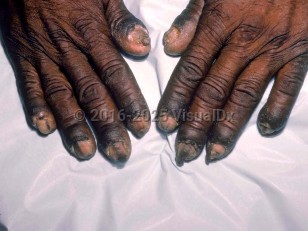Pachydermoperiostosis syndrome
Alerts and Notices
Important News & Links
Synopsis

Pachydermoperiostosis (PDP), also known as Touraine-Solente-Golé syndrome and primary hypertrophic osteoarthropathy, is a very rare genodermatosis marked by facial skin thickening, furrowing and oiliness (pachydermia), digital clubbing, and periostosis. Inheritance is either autosomal dominant (more common) with incomplete penetrance or autosomal recessive. The disease is markedly more common in males than females, with a peak age of onset occurring in adolescence. PDP has 3 clinical phenotypes: a complete form (periostosis and pachydermia), an incomplete form (without pachydermia), and a forme fruste (pachydermia with minimal skeletal changes). The complete phenotype is characterized by progressive pachydermia, periosteal bone formation in the long bones, digital clubbing, and painful joint swelling. Joint involvement may show hydrarthrosis or hemarthrosis. Associated skin findings include seborrhea, hyperhidrosis of the palms and soles, acne, blepharoptosis, eczema, and cutis verticis gyrata. Skin and bone manifestations tend to progress for 5–20 years before stabilizing.
Related topic: secondary hypertrophic osteoarthropathy
Related topic: secondary hypertrophic osteoarthropathy
Codes
ICD10CM:
M89.40 – Other hypertrophic osteoarthropathy, unspecified site
SNOMEDCT:
88220006 – Pachydermoperiostosis syndrome
M89.40 – Other hypertrophic osteoarthropathy, unspecified site
SNOMEDCT:
88220006 – Pachydermoperiostosis syndrome
Look For
Subscription Required
Diagnostic Pearls
Subscription Required
Differential Diagnosis & Pitfalls

To perform a comparison, select diagnoses from the classic differential
Subscription Required
Best Tests
Subscription Required
Management Pearls
Subscription Required
Therapy
Subscription Required
References
Subscription Required
Last Updated:05/05/2022
Pachydermoperiostosis syndrome

